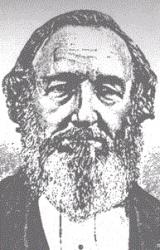Planning worship?
Check out our sister site, ZeteoSearch.org,
for 20+ additional resources related to your search.
- |
User Links
Person Results
Anonymous
Author of "Hail, ye sighing sons of sorrow" in TTT-Himnaro Cigneta In some hymnals, the editors noted that a hymn's author is unknown to them, and so this artificial "person" entry is used to reflect that fact. Obviously, the hymns attributed to "Author Unknown" "Unknown" or "Anonymous" could have been written by many people over a span of many centuries.
Anonymous
William Moore
1790 - 1850 Composer of "HOLY MANNA" in TTT-Himnaro Cigneta William B Moore USA 1790-1850. He was born, possibly in TN. He was a composer, having contributed tunes to” Wyeth’s Repository” (1810) and known for his tunebook “Columbian Harmony” (1825) in TN. He also composed and arranged several tunes in William Walker’s “Southern Harmony” (1835).
John Perry
William Moore
James P. Carrell
1787 - 1854 Person Name: Carrell Composer of "THE MOULDERING VINE" in The Southern Harmony, and Musical Companion (New ed. thoroughly rev. and much enl.) James P. Carrell was a "farmer, Methodist minister, and county clerk in Lebanon, Russell County, Virginia. He was author of the Songs of Zion (1821) and co-author of Virginia Harmony (1831)" (Steel and Hulan 2010). Several of his songs were printed in Kentucky Harmony and its supplements.
James P. Carrell
William Hauser

1812 - 1880 Person Name: Wm. Houser Treble by of "SONS OF SORROW" in The Social Harp The Reverend Dr. William Clarke Hauser was a minister, medical doctor, teacher, composer, and music publisher. He was born December 23, 1812 in Bethania, Forsyth County, North Carolina, USA, and died September 15, 1880 in Wadley, Jefferson County, Georgia. He was the son of Martin Hauser and Leah Billiter.
William Hauser united with the Methodist Church in 1827 and was licensed to preach in 1834 and was a circuit riding preacher for two years. On March 23, 1837, he married Eliza M. Renshaw (1813-1880), and they had three children: Carolina Elizabeth Hauser Parker (1838-1926), William Clarke Hauser (1844-1919), and Victor McLandhton Hauser (1847-1919). William Hauser raised his family in New Orleans, LA and Victor Hauser did the same in Ogden, Utah. William Hauser attended Henry College in Virginia, beginning in 1839. After moving to Georgia in 1841, he began the study of medicine. He later taught at Oglethorpe Medical College in Savannah, GA.
Hauser made two significant contributions in the area of shape note music: (1) The Hesperian Harp: a Collection of Psalm and Hymn Tunes, Odes and Anthems, published in four shapes at Philadelphia by T. K. Collins, Jr. in 1848; and (2) Olive Leaf: A Collection of Beautiful Tunes, New and Old; the Whole of One or More Hymns Accompanying Each Tune, for the Glory of God, and the Good of Mankind, published in seven shapes at Wadley, Georgia, by Hauser and Benjamin Turner in 1878. The Hesperian Harp was probably the largest shape note tune book of its day, containing 552 pages of music, including 36 songs composed by Hauser. His Olive Leaf was produced in the seven shape notes of Jesse B. Aikin and contained only eight of his compositions from the older book. But his new compositions numbered forty-eight. The Moravian Music Foundation calls Dr. William Hauser "Appalachia's most significant contribution to American music."
Dr. Hauser died on September 18, 1880. His last words were ″I feel that my work on earth is done, and there is not a cloud between me and God.″ William and Eliza Hauser are buried on their plantation, Hesperia, near Wadley in Jefferson County, Georgia.
--en.wikipedia.org/wiki/
William Hauser


 My Starred Hymns
My Starred Hymns

